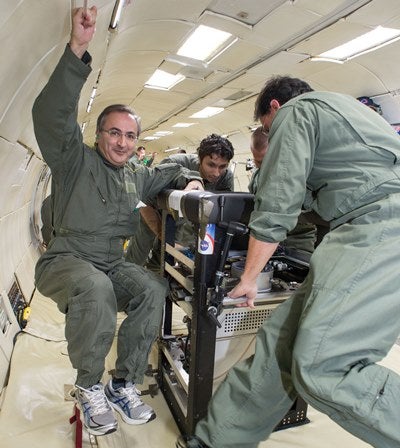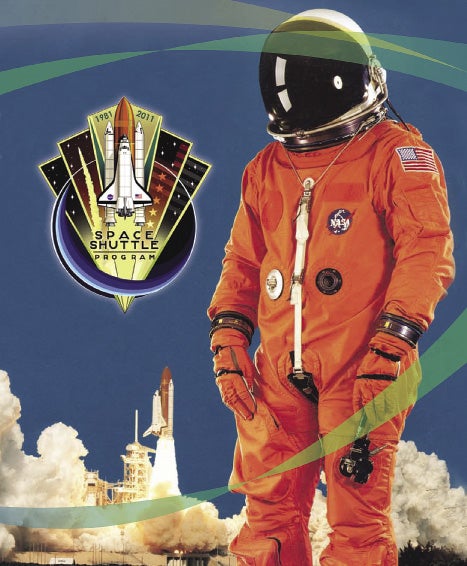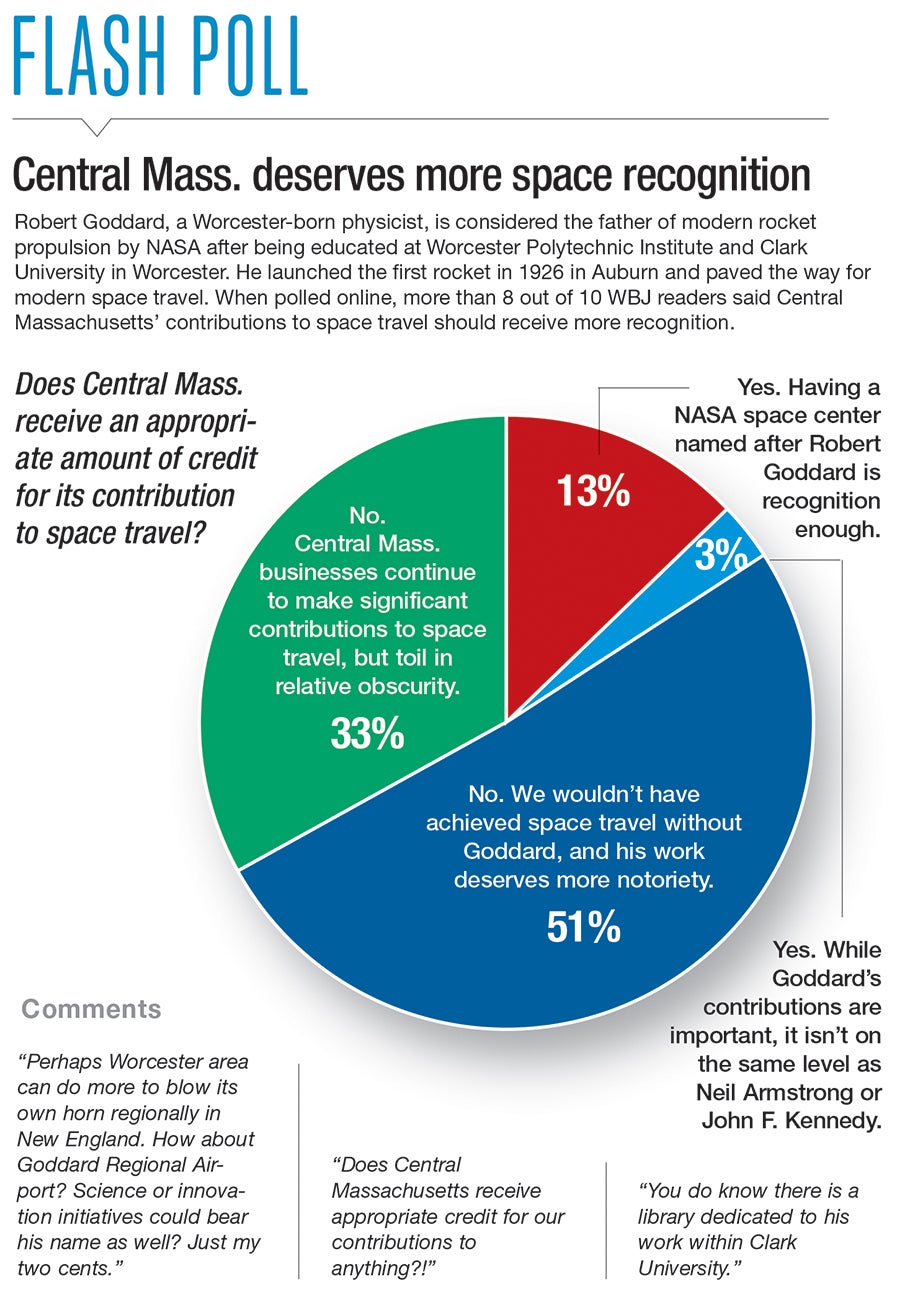On a clear early spring day in 1926, Robert Goddard went into a field in Auburn and – for the first time in recorded history – shot off a rocket, with the utilitarian liquid-fueled apparatus flying 41 feet up through the air.
Few saw the flight lasting only a few seconds and no news stories recorded the event, but the Worcester-born physicist had just paved the way for what more than four decades later would bring Americans to the moon.
As the 50th anniversary of the Apollo 11 landing on the moon was marked on July 20, Goddard’s name might not be nearly as central to the story as Buzz Aldrin or Neil Armstrong, but that flight may not have happened if not for Goddard, who studied at Clark University and Worcester Polytechnic Institute and was a faculty member at Clark for decades.
“I’m not sure where we would be today without that innovation,” said David Alexander, the director of the Rice Space Institute in Houston.
More than 100 years after Goddard first explored using rockets to reach the moon, the history of space travel remains intertwined with Central Massachusetts, from the company designing space suits, to university research, to the college president who laid the groundwork for the next generation of human space exploration, to the startup companies tasked with helping NASA again achieve the moon, as the first stop on the way to Mars.

“We’re kind of the Kitty Hawk of modern space exploration,” said Charles Slatkin, a Clark graduate and a strong advocate of Goddard, referring to the North Carolina location where the Wright brothers had their famous first airplane flight.
It all started with Goddard
NASA said in a 90th anniversary commemoration of Goddard’s inaugural rocket none of the American space program could be possible without his work. The agency named after Goddard its space flight center in Maryland, where it has its largest number of scientists, engineers and others who build spacecraft and technology to study Earth and space.
“He was extremely critical to the space program,” said Fordyce Williams, Clark’s coordinator of archives and special collections.
That Goddard would one day be cited as so instrumental to our space explorations would have seemed unlikely in his day. His ideas about reaching space – something he wrote about in 1909, with thoughts of interplanetary travel – were ridiculed at the time, according to NASA.
Goddard, who was born in Worcester in 1882, graduated from WPI as a general science major in 1908. There he began working on a rocket in a basement lab of a physics building.
He served on WPI’s Physics Department faculty for two years before becoming a graduate student at Clark. He earned his master’s in physics in 1910 and his doctorate a year later.
Three years after graduation, Goddard already received patents for rockets using both liquid and solid fuels. By 1920, he wrote in a report his vision of sending a rocket to the moon.
Until Goddard, rocket technology had advanced little in centuries, since rockets began using gunpowder in the 13th century, according to NASA. But Goddard saw benefits of using liquid fuel instead, and spent the next 17 years working on firing a rocket off the ground, using grant funding from the Smithsonian Institution in Washington, D.C. and the Daniel Guggenheim Foundation.
He finally did so on March 16, 1926, on a farm in Auburn today part of the Pakachoag Golf Course. Goddard’s diary entry that day said precious little – the rocket had fired up 41 feet and went horizontally 184 feet, a flight of about 2.5 seconds.
The milestone came and went with little notice. After all, with so many false starts behind him, it wasn’t as if Goddard knew the rocket would suddenly launch that day.
“There were plenty of times when it didn’t work,” Williams said.
A day later, though, Goddard had a chance to reflect a bit more about what had happened.
“Even though the release was pulled, the rocket did not rise at first, but the flame came out, and there was a steady roar,” he wrote. “After a number of seconds it rose, slowly until it cleared the frame, and then at express train speed, curving over to the left, and striking the ice and snow, still going at a rapid rate.

“It looked almost magical as it rose, without any appreciably greater noise or flame,” Goddard wrote, “as if it said, ‘I’ve been here long enough; I think I’ll be going somewhere else, if you don’t mind.’”
Alexander, from Houston, compared Goddard’s contributions to two other trailblazers whose names are also not particularly well known: Konstantin Tsiolkovsky, a Russian scientist who developed a prominent theory on rocket power a quarter-century before Goddard’s inaugural launch, and Wernher von Braun, a German-born scientist who was among the top developers of NASA’s space missions starting in the 1950s.
NASA calls Goddard’s achievements as significant to history as the Wright brothers’ first flight in 1903. In fact, Aldrin – whose father was a student of Goddard’s – came to Clark just a month before the July 1969 Apollo 11 launch to help inaugurate the university’s new library in Goddard’s name.
“At that time, just being able to control the combustion, to get the performance out of the engine, that was groundbreaking work,” said Ramon Lugo, the director of the Florida Space Institute at the University of Central Florida.
Lingering legacy in Worcester
While rocket-fueled space exploration took its roots from that field in Auburn in 1926, Goddard’s success was hardly the last time American space exploration would rely on Central Massachusetts ingenuity.
Worcester manufacturer David Clark Co. designed and manufactured the space suits worn in the early phases of the NASA program, the Gemini missions in 1965 and 1966. Though another manufacturer was used by the time Apollo 11 made it to the moon, David Clark provided suits for the Space Shuttle era, which lasted from 1981 to 2011, and the Constellation program from 2005 to ‘09.
David Clark continues to provide space suits today for the Orion program, which is setting a foundation for deep-space exploration, and the Commercial Crew program, which works with private partners including Boeing and SpaceX to develop new human space flights.
A David Clark subsidiary is providing all the hardware, connectors, helmet and visor assemblies for an extravehicular mobility unit servicing the International Space Station, said Daniel Barry, the company’s vice president for aerospace life support systems.
In Westford, the Haystack Observatory is part of MIT’s facilities to research astronomy. The complex includes the Westford Radio Telescope, built in 1961, which has been used to test long-range communications and enhance researcher’s understanding of Earth’s positioning in space.

A central figure to NASA’s latest efforts to further future human space exploration is WPI President Laurie Leshin, whose Twitter account – @LaurieOfMars – is full of odes to her love of space travel and her time with the space agency.
Leshin joined NASA in 2005 as director of science and exploration at the Goddard Space Flight Center. She later became deputy associate administrator for exploration systems, playing a major role in everything from NASA’s aid for startup missions and space-based telescopes and other instruments studying the sun, moon and planets, to developing future human spaceflight activities and commercial capabilities for low-Earth orbit transport.
Leshin published more than 40 scientific papers and won NASA’s Distinguished Public Service Medal in 2004 after developing an interdisciplinary School of Earth and Space Exploration at Arizona State University. The International Astronomical Union recognized her contributions to planetary science by naming an asteroid after her.
She became WPI’s president in 2014.
Academic research
While Clark University in Worcester is no engineering or science powerhouse today, one physics professor, Michael Boyer, is carrying the torch from Goddard in a small way through research he is performing with a Wellesley College professor seeking to find how molecules form in dust clouds found in spaces between stars. The researchers grow ice in a vacuum as a simulator for deep space.

“We’re trying to understand the origins of life,” Boyer said.
At WPI, a team of researchers led by electrical and computer engineering professor Alexander Wyglinski, used the International Space Station to test space communications with implications for future space missions. The just-concluded research, for which NASA contributed funding, improves gaps in communications caused by space’s harsh weather conditions or other impairments in part through artificial intelligence.
Wyglinski and other researchers are working now on peer-reviewed articles to help give the rest of the space industry insights from their work.
“It’s foundational work for anyone who wishes to continue and find new ways to communicate in space,” he said. “We’re demanding more and more from these missions than ever before.”
Another WPI professor, Jamal Yagoobi, the head of the mechanical engineering department, has lead research into ways of better keeping spacecraft cool during long missions when they are bombarded with solar radiation. The system uses electrically charged fluids to absorb and carry heat away from electronics and other equipment that generates heat.
Yagoobi’s experiment has used the International Space Station, and its results could be especially important for a potential trip to Mars – or back on Earth, in cooling, heating and ventilations systems. Unlike mechanical cooling systems used today, Yagoobi’s system requires minimal electric power and no noise or vibrations.
A first experiment at the International Space Station over roughly a year and a half ended in August, with a second phase expected in 2021 and 2022 to test a more advanced version of the cooling system.
Yagoobi has received NASA funding for each of the past 26 years to support his cooling-system research.
The new space startups
In June, NASA awarded three Central Massachusetts companies part of $45 million to develop systems to help the agency put humans back on the moon in five years and on Mars by 2030.
Charlton-based Incom is developing components for advanced imaging systems to enable researchers to get a clearer image of particles in deep space, and Worcester startup MultiScale Systems seeks to make vehicles safer using geometric patterns.
The third – Natick propulsion company Busek Co. Inc. – uses technology once advanced by Goddard to build and design thrusters for the aerospace industry.

“He’s really a founding father for the technology,” said Peter Hruby, business and strategy director at Busek.
Busek relies on electric-based propulsion, an idea studied by Goddard even while he was studying chemical liquid fueled-based propulsion; Goddard has the first ever patent for an electrostatic thruster.
Electric propulsion systems can sustain flight for longer periods of time, so they are typically used for deep-space missions while chemical propulsion systems are typically more powerful and can thrust large spacecraft out of Earth’s atmosphere.
Busek’s work focuses around electric ion thrusters.
Goddard’s research from more than 100 years ago has helped WPI forge a working relationship with Busek and NASA.

“For smaller spacecraft, [the ion thruster is] definitely one of the industry’s favorite forms of engines,” said Nikos Gatsonis, director of WPI’s aerospace engineering program.
Busek is one of the main private partnerships in the aerospace engineering program, Gatsonis said, with students working for the company during and after their education.
Some of the school’s most notable work in electric propulsion came in 2007, when Busek, with the help of WPI students, developed a micro-pulsed plasma thruster, which powered a U.S. Air Force satellite.
Busek has more than a dozen products somewhere in space at the moment. Some power satellites in lower-Earth orbit while others are on the far side of the moon, Hruby said.
“That equipment will be there until the pyramids turn to sand,” he said.
Busek now is working on thrusters to power a small toaster oven-sized spacecraft flying to the moon in 2020 in search of water deposits on its north and south poles.
“A lot of the motivation is in building a product to meet NASA’s demanding needs,” Hruby said. “Some thrusters have out-of-the-world performance and precision, while others are real workhorses that are opening up and enabling new missions in both lower-Earth and outer-Earth orbit and beyond.”
WBJ Staff Writer Zachary Comeau contributed to this story.

